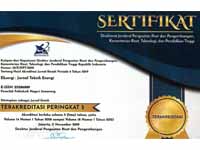Experimental Study Of The Performance Of A 5-Bladed Horizontal Axis Wind Turbine Of NACA 4415 Profile Using Winglets With Winglet Height Variation
DOI:
https://doi.org/10.32497/eksergi.v20i02.5803Keywords:
HAWT, NACA 4415 airfoil, wind turbine efficiency, winglet, vortexAbstract
Horizontal axis wind turbine is one type of
turbine used to convert wind energy into mechanical energy. The
purpose of this research is to design, manufacture, test and
analyze the performance of horizontal shaft wind turbine NACA
4415 airfoil blades that do not use winglets with those that use
winglet height variations. The stages of this research include
preparation of literature search, planning and making NACA
4415 airfoil blades both using winglets and not using winglets,
assembling test equipment and assembling wind turbine
installations, testing and taking wind turbine performance data,
data processing and analysis, final results. The turbine diameter
used is 1.1m with a blade thickness of 18 mm and a chord length
of 38mm. Tests were carried out with winglet height test
variables of 5%, 7%, 9%, and 11% of the rotor length at wind
speeds of 4 m/s, 6 m/s, 8 m/s and 10 m/s. The test results show
that the NACA 4415 airfoil horizontal shaft wind turbine using
a winglet with a height of 7% has optimum performance at 4 m/s
and 6 m/s with efficiencies of 23.68% and 8.75%, respectively,
while when the wind speed is 8 m/s and 10 m/s the optimum
turbine performance is achieved when using a 9% winglet with
efficiencies of 6.12% and 3.64%, respectively. The most
optimum turbine performance improvement is achieved when
using a 7% winglet with an efficiency increase of 204.76% at a
wind speed test of 4 m/s.
Keywords”” HAWT,
Downloads
Published
Issue
Section
License
Authors who publish with this journal agree to the following terms:Authors retain copyright and grant the journal right of first publication with the work simultaneously licensed under a Creative Commons Attribution License that allows others to share the work with an acknowledgement of the work's authorship and initial publication in this journal.
Authors are able to enter into separate, additional contractual arrangements for the non-exclusive distribution of the journal's published version of the work (e.g., post it to an institutional repository or publish it in a book), with an acknowledgement of its initial publication in this journal.
Authors are permitted and encouraged to post their work online (e.g., in institutional repositories or on their website) prior to and during the submission process, as it can lead to productive exchanges, as well as earlier and greater citation of published work (See The Effect of Open Access).






